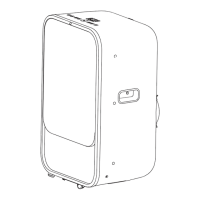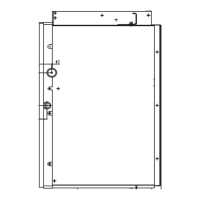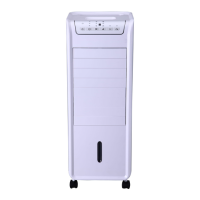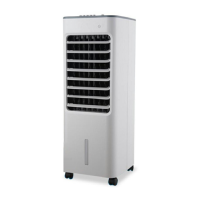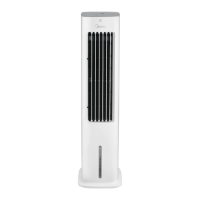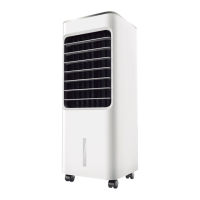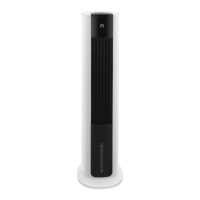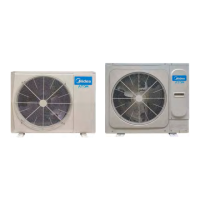Do you have a question about the Midea AIR CONDITIONER and is the answer not in the manual?
Requires professional installation. Avoid contact with moving fan parts and high voltage inside the unit.
Prevent electrical shock by avoiding water contact. Operate within conditions and manage room temperature for safety.
Do not service the unit yourself. Disconnect power before cleaning to prevent electric shock.
Identifies and labels the various parts of the indoor air conditioning unit.
Identifies and labels the various parts of the outdoor air conditioning unit.
Explains the indicators and their functions on the air conditioner's display panel.
Tips include maintaining room temperature, cleaning filters, managing doors/windows, using curtains, and timer functions.
Place controller for signal reception. Avoid damage, sunlight, and interference. Follow battery guidelines.
Guidelines for battery replacement, storage, life, and replacement indicators for the remote.
Steps to operate the unit temporarily by using the manual switch on the indoor unit.
Adjusts the horizontal louvers for desired airflow direction, including automatic swing.
Adjusts the vertical louvers by hand for desired airflow direction.
Instructions for cleaning the indoor unit and remote controller using dry cloth.
Steps for cleaning air filters and refreshing filters like active carbon and light catalyst.
Protects the compressor by preventing immediate restart after power interruption.
Information on unit behavior during power failure and restart procedures.
Details on preheating, warm air control, and defrosting for heating operation.
Specifies the recommended indoor and outdoor temperature ranges for cooling, heating, and dehumidification.
Notes on operation beyond specified conditions and performance in high humidity.
Guidelines for selecting a suitable location for the outdoor and indoor units.
Instructions for proper electrical wiring and grounding to prevent shock.
Precautions regarding noise, vibration, and potential interference.
Advice on how to relocate the air conditioner, requiring professional service.
Checks for common reasons the unit may not operate, such as fuse or battery issues.
Checks for issues like blocked inlets/outlets, dirty filters, or incorrect settings.
Conditions requiring immediate shutdown and dealer contact, like flashing lamps or erratic operations.
Troubleshooting common problems with the remote controller, such as fan speed or indicator issues.
Requires professional installation. Avoid contact with moving fan parts and high voltage inside the unit.
Prevent electrical shock by avoiding water contact. Operate within conditions and manage room temperature for safety.
Do not service the unit yourself. Disconnect power before cleaning to prevent electric shock.
Identifies and labels the various parts of the indoor air conditioning unit.
Identifies and labels the various parts of the outdoor air conditioning unit.
Explains the indicators and their functions on the air conditioner's display panel.
Tips include maintaining room temperature, cleaning filters, managing doors/windows, using curtains, and timer functions.
Place controller for signal reception. Avoid damage, sunlight, and interference. Follow battery guidelines.
Guidelines for battery replacement, storage, life, and replacement indicators for the remote.
Steps to operate the unit temporarily by using the manual switch on the indoor unit.
Adjusts the horizontal louvers for desired airflow direction, including automatic swing.
Adjusts the vertical louvers by hand for desired airflow direction.
Instructions for cleaning the indoor unit and remote controller using dry cloth.
Steps for cleaning air filters and refreshing filters like active carbon and light catalyst.
Protects the compressor by preventing immediate restart after power interruption.
Information on unit behavior during power failure and restart procedures.
Details on preheating, warm air control, and defrosting for heating operation.
Specifies the recommended indoor and outdoor temperature ranges for cooling, heating, and dehumidification.
Notes on operation beyond specified conditions and performance in high humidity.
Guidelines for selecting a suitable location for the outdoor and indoor units.
Instructions for proper electrical wiring and grounding to prevent shock.
Precautions regarding noise, vibration, and potential interference.
Advice on how to relocate the air conditioner, requiring professional service.
Checks for common reasons the unit may not operate, such as fuse or battery issues.
Checks for issues like blocked inlets/outlets, dirty filters, or incorrect settings.
Conditions requiring immediate shutdown and dealer contact, like flashing lamps or erratic operations.
Troubleshooting common problems with the remote controller, such as fan speed or indicator issues.
| Brand | Midea |
|---|---|
| Cooling Capacity | Varies by model |
| Heating Capacity | Varies by model |
| Energy Efficiency Ratio (EER) | Varies by model |
| SEER Rating | Varies by model |
| HSPF Rating | Varies by model |
| Refrigerant | R32 or R410A |
| Power Supply | 220-240V, 50Hz |
| Noise Level | Varies by model |
| Dimensions (Indoor Unit) | Varies by model |
| Dimensions (Outdoor Unit) | Varies by model |
| Weight (Indoor Unit) | Varies by model |
| Weight (Outdoor Unit) | Varies by model |
| Features | Sleep Mode, Timer |
| Type | Split Air Conditioner |
